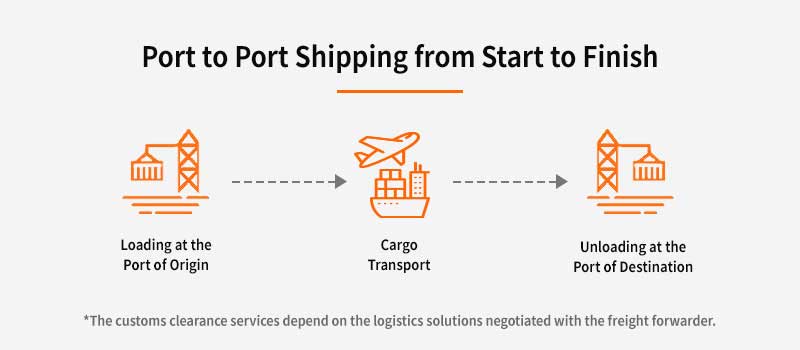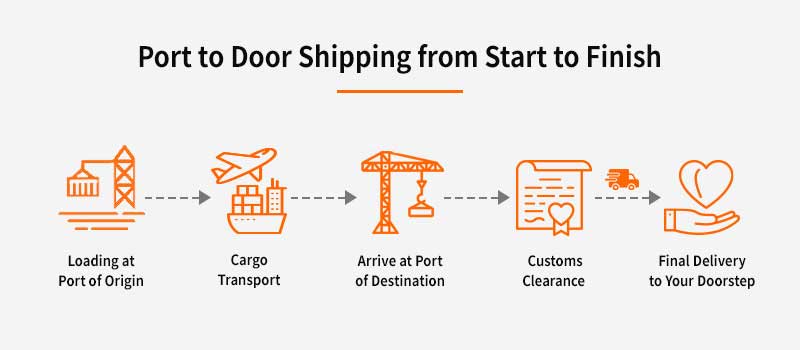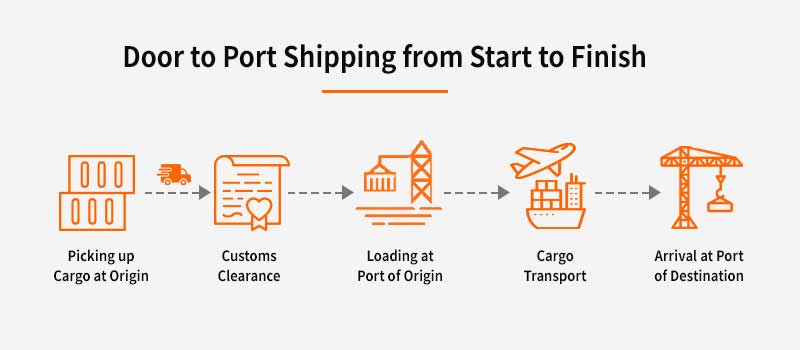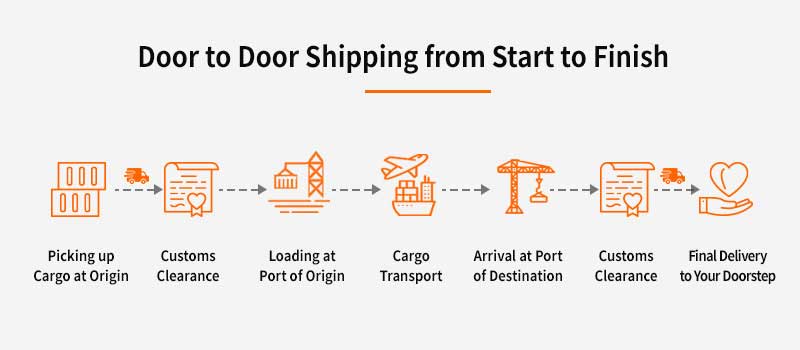Freight forwarders typically provide a range of services and transport options tailored to the requirements of shippers and consignees. It is where terms such as port-to-port, port-to-door, door-to-port, and door-to-door movement types come in.
While it can infer the basic meanings of these terms from their names, a comprehensive understanding of these diverse shipping methods is essential. This article guides you through their functionalities, advantages, disadvantages, and the appropriate Incoterms, offering an in-depth exploration of these subjects.
Port-to-port international shipping
Port-to-port shipping is a method in which goods are transported from one specific port to another port of destination. This shipping process primarily involves the cargo movement between two specified ports, constituting the intermediary leg within the entire logistics operation.
Generally, the primary determinant for port-to-port shipping transit time is the geographical distance between the origin and destination ports. Longer distances naturally result in extended transit times. For instance, sea freight from China to the USA can vary from 3 to 4 weeks, while to Southeast Asia will take 1 to 2 weeks.

Benefits of port-to-port Shipping
Port-to-port shipment is known for its cost-effectiveness, as it optimizes direct routes between ports, minimizing unnecessary detours and associated expenses.
In a standard PTP process, there’s no involvement of a transport chain. It means you are not bound to a specific freight forwarder’s schedule; instead, you obtain the flexibility to select your shipping partners at both the origin and destination ports.
With port to port delivery encompassing just a single main run, reserving and monitoring your cargo becomes more straightforward. Additionally, the direct journey of the cargo from one port to another, without intermediate stops, significantly diminishes the risk of mishandling, loss, or damage.
However, port-to-port shipping may lack the convenience of door-to-door delivery, posing challenges for consignees who prioritize direct shipment to their doorstep.
Services included in port-to-port shipment
Services at origin
Initiate the shipping process by booking and reserving cargo space on a vessel. Provide additional services to meet customers’ needs, including handling and loading from the port of origin, port arrival notification, etc.
Transport services
The primary service involves the actual maritime transport of goods from one port to another. They offer various options in port-to-port shipping, such as the management and submission of shipping documents, customs clearances, vessel tracking and monitoring, and more.
Destination port services
Expert unloading of cargo upon reaching the destination port is a fundamental service. Moreover, it provides a range of services, including storage, notification of cargo arrival, and delivery to the consignee.
Our ASLG can provide the latest port to port schedules as we work directly with the ship owner. Meanwhile, you can also enjoy competitive rates and premium customer support.
Port-to-Port Incoterms
Incoterms serve as a crucial set of rules defining the responsibilities of sellers and buyers during cargo transportation. Commonly used Incoterms for port-to-port shipping are:
C-Clause terms (CFR, CIF, CPT, and CIP)
D-Clause terms (DDP, DAP, and DPU).
PTP vs. Port-to-Door shipping
In port-to-door shipping, the freight forwarder takes charge of the cargo movement from the port of loading to the consignee’s specified location. It entails arranging inland transport at the destination to fulfill the freight shipment.
Unlike PTP shipping, it provides a convenient and efficient solution for consignees who prefer a seamless shipment process to their doorstep.
Nevertheless, shipping from port-to-door typically incurs higher costs than port-to-port shipping because of the additional solutions, such as last-mile delivery.

Port-to-door Incoterm
The term “Port to Door” does not correspond to a specific Incoterms in the traditional Incoterms framework. However, the closest shipping terms representation to a port-to-door arrangement is as follows:
CPT (Carriage Paid To): In this scenario, the seller is obligated to present the goods at the location specified by the buyer.
DDP (Delivery Duty Paid): Under this term, the seller should deliver the goods directly to the buyer’s designated warehouse or premises.
PTP vs. Door to Port shipping
Door-to-port shipping involves the process of collecting goods from the supplier and delivering them to the ocean port or airport of origin.
Upon the goods arriving at the destination port, the shipper or consignee assumes responsibility for local inland transport.
In this shipping solution, the freight forwarder employs multimodal transport, typically utilizing a truck and vessel/aircraft.
For those unable to coordinate shipments from their supplier to the selected Port of Loading, door-to-port is a more suitable option than PTP.

Door to port Incoterms
Common Incoterms that involve door-to-port shipping include:
CPT (Carriage Paid To): Under this Incoterm, the seller bears obligations until the goods are loaded, while the buyer takes charge of inland shipping at the destination, akin to how door-to-port works.
DPU (Delivered at Place): In door-to-port shipping, the seller bears the costs and risks, making the DPU term a suitable and straightforward option.
CIP (Carriage and Insurance Paid To): The seller holds responsibility until the goods are unloaded, and they secure insurance to cover the transportation from the door to the port.
Port-to-Port vs. Door-to-Door
Door-to-door shipping is a logistics approach that provides end-to-end services, seamlessly managing the movement of goods from the supplier’s location to the consignee’s specified door address.
It contains multiple modes of transportation, including air, sea, road, and rail, to ensure a seamless flow of goods.
When opting for door-to-door shipping from China, two main Incoterms come into play: DDP (Delivered Duty Paid) and DDU (Delivered Duty Unpaid).
In general, door-to-door shipping streamlines processes and diminishes overall transit times, albeit at a potentially higher cost than port-to-port shipping.
For in-depth insights door-to-door, you can check this article.

Which transport types should you choose?
The best choice always depends on your specific logistics needs and budget considerations.
If cost savings are a priority, port-to-port shipping might be suitable. Conversely, if you prefer a smooth and seamless experience, door-to-door is convenient, though with a higher cost.
On the other hand, port-to-door and door-to-port strike a balance between cost-effectiveness and convenience, depending on which leg of the journey you want to manage.
Conclusion
At Airsupply, we take pride in offering comprehensive services designed to cater to your specific shipping needs. Whether you opt for port-to-port, door-to-door, or other options, we’ve got you covered.
Our commitment extends beyond merely facilitating the transportation of your goods; we aim to deliver a seamless and personalized shipping experience.
Furthermore, we offer state-of-the-art port to port tracking solutions to enhance transparency and provide you with real-time information.




